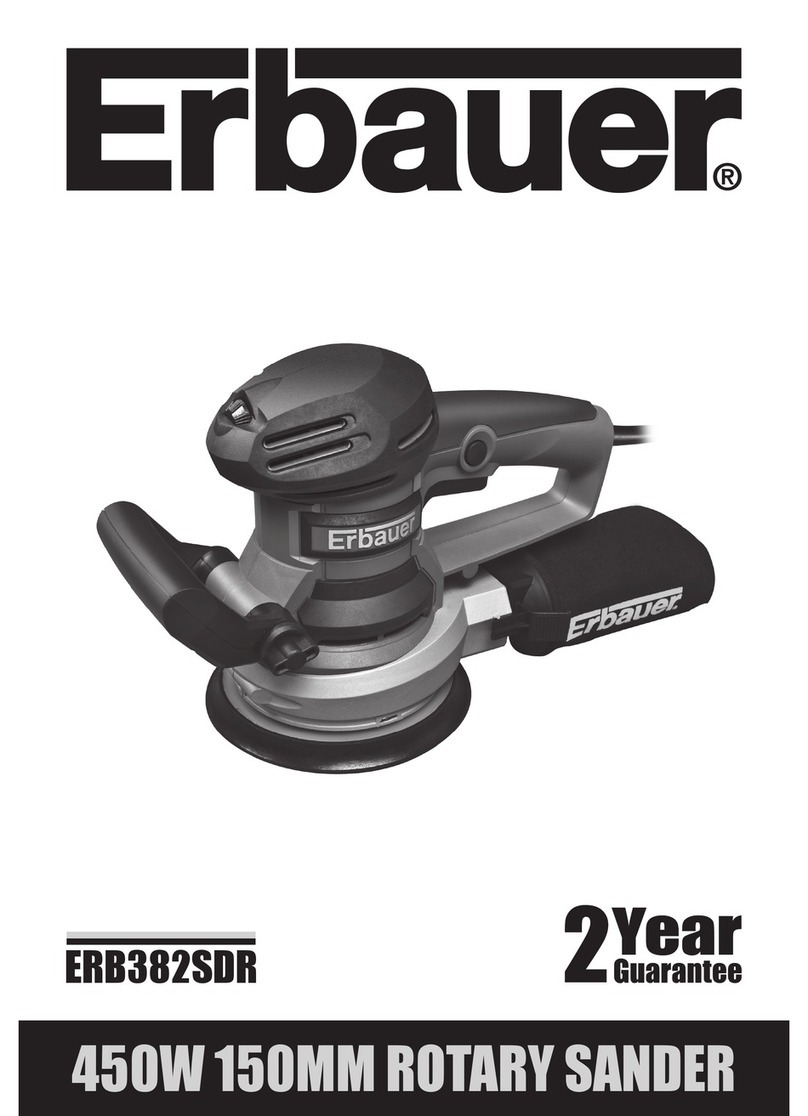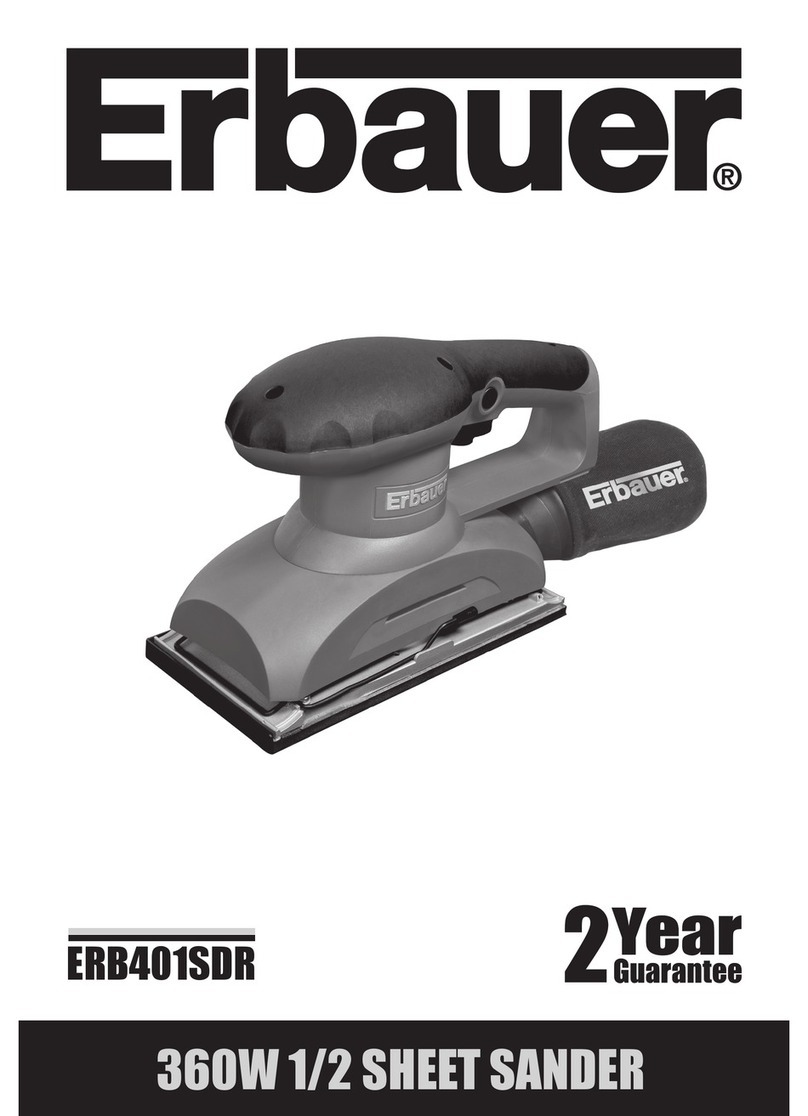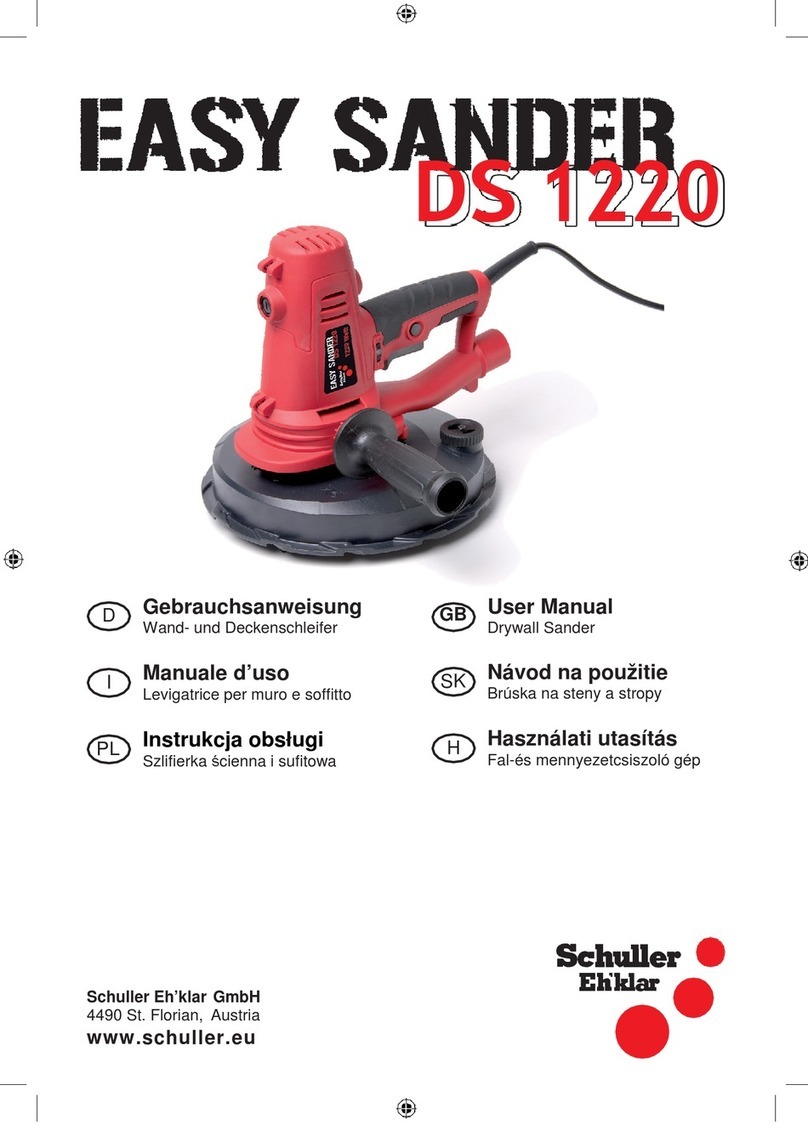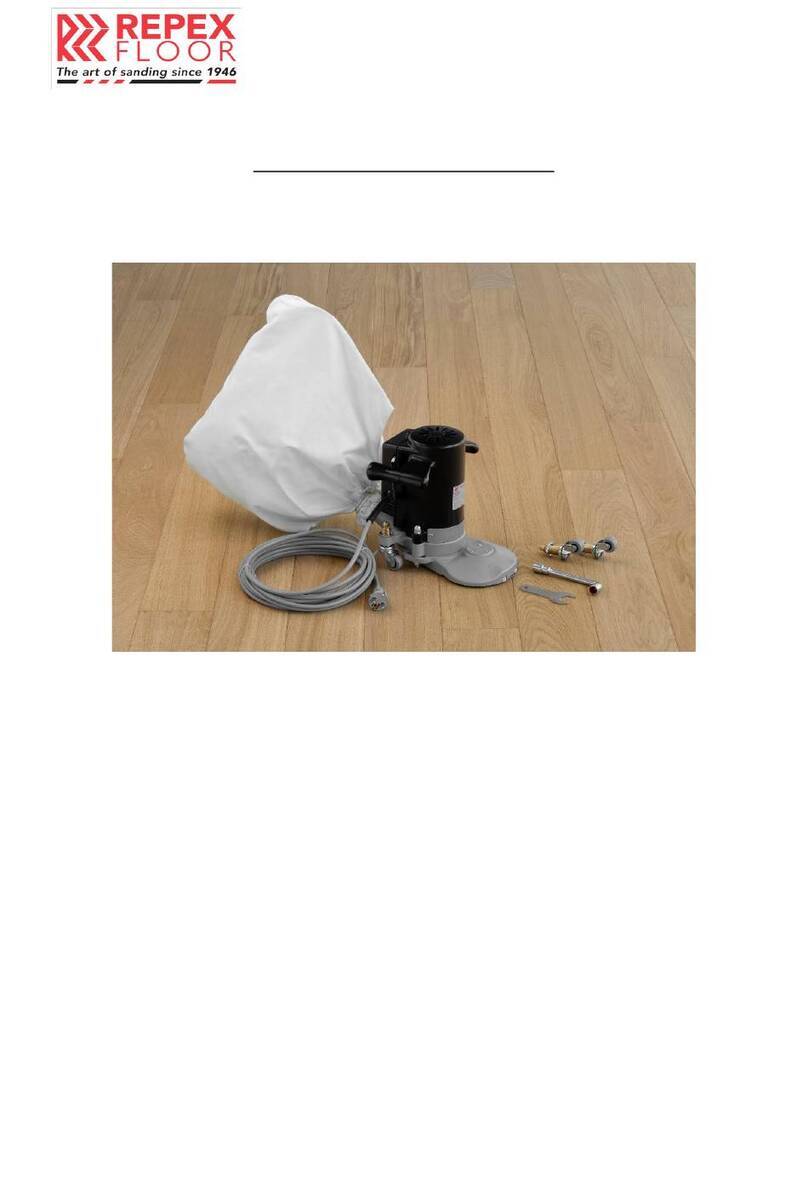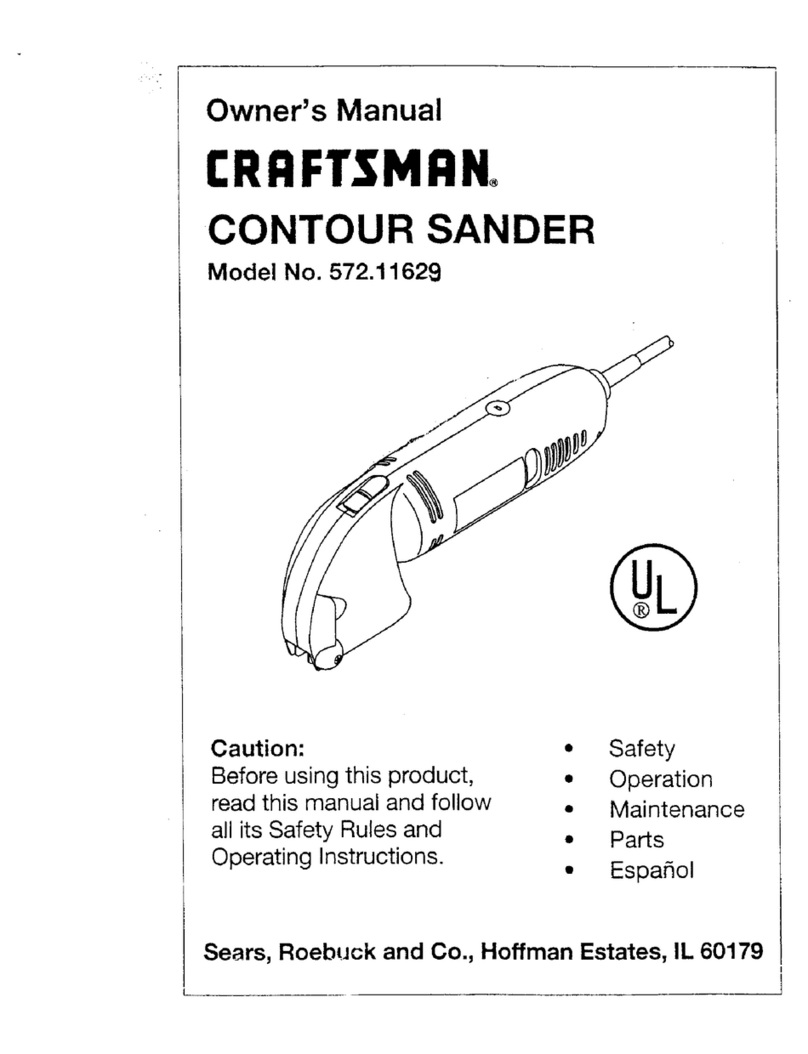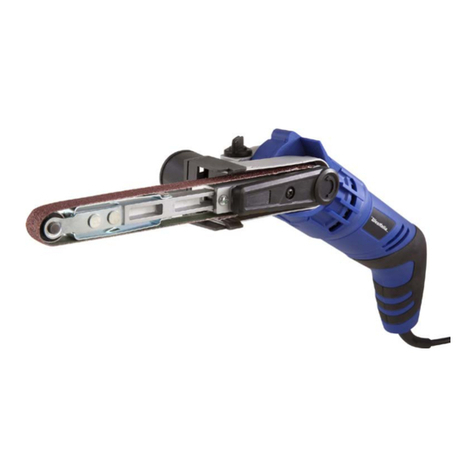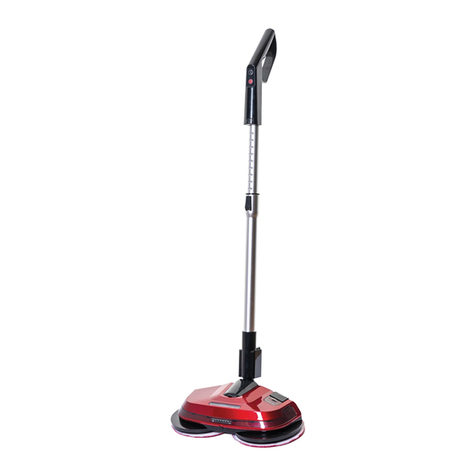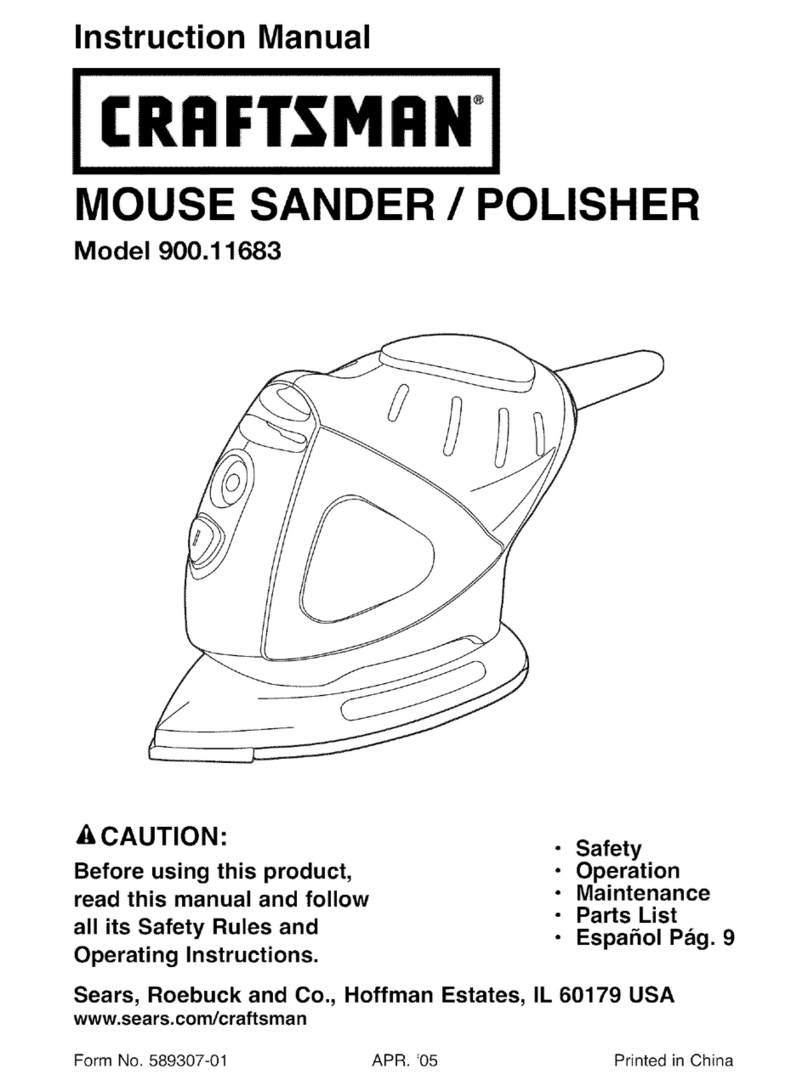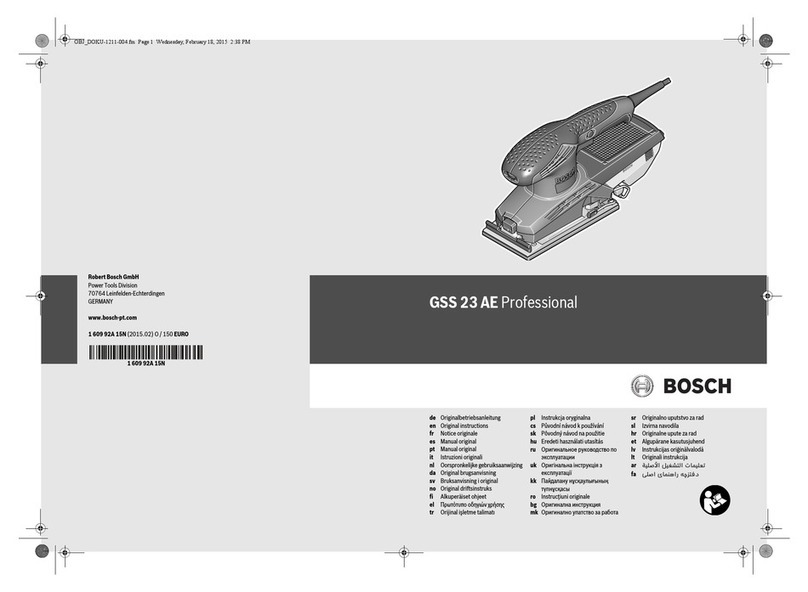Erbauer ERB404SDR User manual

240W 1/4 SHEET SANDER
ERB404SDR

240W 1/4 SHEET SANDER
Original Instructions
(Version 2.0)

240W 1/4 SHEET SANDER
GUARANTEE
This product carries a 2 year guarantee. If your product develops a fault within this
period, you should in the rst instance contact the retailer where the item was purchased.
This guarantee specically excludes losses caused due to:
- Fair wear and tear
- Misuse or abuse
- Lack of routine maintenance
- Failure of consumable items (such as batteries)
- Accidental damage
- Cosmetic damage
- Failure to follow manufacturer’s guidelines
- Loss of use of the goods
This guarantee does not affect your statutory rights. This guarantee is only valid in the UK.
For further technical advice, spare parts or repair service (outside of guarantee) please con-
tact the customer helpline number on 0345 607 6380.
Congratulations on your purchase of a quality power tool from Erbauer (UK) Ltd. This
product should give you reliable service but for your peace of mind this
power tool does carry a 2 year guarantee, the terms of which are detailed below.
If this product develops a fault within the guarantee period contact your retailer.
Please retain this handbook in case you need to refer to safety, care or guarantee
information in the future.

240W 1/4 SHEET SANDER
GENERAL POWER TOOL SAFETY WARNINGS
Warning: Read all safety warnings and all instructions.
Failure to follow the warnings and instructions may result in
electric shock, re and/or serious injury.
Save all warnings and instructions for future reference.
The term “power tool” in the warnings refers to your electric (corded)
power tool or battery-operated (cordless) power tool.
1. Work area safety
a. Keep work area clean and well lit. Cluttered or dark areas
invite accidents.
b. Do not operate power tools in explosive atmospheres,
such as in the presence of ammable liquids, gases or dust.
Power tools create sparks which may ignite the dust or fumes.
c. Keep children and bystanders away while operating a
power tool. Distractions can cause you to lose control.
2. Electrical safety
a. Power tool plugs must match the outlet. Never modify the
plug in any way. Do not use any adapter plugs with earthed
(grounded) power tools. Unmodied plugs and matching outlets
will reduce risk of electric shock.
b. Avoid body contact with earthed or grounded surfaces,
such as pipes, radiators, ranges and refrigerators. There
is an increased risk of electric shock if your body is earthed or
grounded.
c. Do not expose power tools to rain or wet conditions. Water
entering a power tool will increase the risk of electric shock.
d. Do not abuse the cord. Never use the cord for carrying,
pulling or unplugging the power tool. Keep cord away from
heat, oil, sharp edges or moving parts. Damaged or entangled
cords increase the risk of electric shock.
e. When operating a power tool outdoors, use an extension
cord suitable for outdoor use. Use of a cord suitable for outdoor
use reduces the risk of electric shock.
f. If operating a power tool in a damp location is unavoidable,

240W 1/4 SHEET SANDER
use a residual current device (RCD) protected supply. Use of
an RCD reduces the risk of electric shock.
3. Personal safety
a. Stay alert, watch what you are doing and use common
sense when operating a power tool. Do not use a power tool
while you are tired or under the inuence of drugs, alcohol
or medication. A moment of inattention while operating power
tools may result in serious personal injury.
b. Use personal protective equipment. Always wear eye
protection. Protective equipment such as dust mask, non-skid
safety shoes, hard hat, or hearing protection used for appropriate
conditions will reduce personal injuries.
c. Prevent unintentional starting. Ensure the switch is in
the off-position before connecting to power source and/or
battery pack, picking up or carrying the tool. Carrying power
tools with your nger on the switch or energising power tools that
have the switch on invites accidents.
d. Remove any adjusting key or wrench before turning the
power tool on.
A wrench or a key left attached to a rotating part of the power tool
may result in personal injury.
e. Do not overreach. Keep proper footing and balance
at all times. This enables better control of the power tool in
unexpected situations.
f. Dress properly. Do not wear loose clothing or jewellery.
Keep your hair, clothing and gloves away from moving parts.
Loose clothes, jewellery or long hair can be caught in moving
parts.
g. If devices are provided for the connection of dust
extraction and collection facilities, ensure these are
connected and properly used. Use of dust collection can
reduce dust-related hazards.
4. Power tool use and care
a. Do not force the power tool. Use the correct power tool for
your application. The correct power tool will do the job better
and safer at the rate for which it was designed.

240W 1/4 SHEET SANDER
b. Do not use the power tool if the switch does not turn it on
and off. Any power tool that cannot be controlled with the switch
is dangerous and must be repaired.
c. Disconnect the plug from the power source and/or
the battery pack from the power tool before making any
adjustments, changing accessories, or storing power tools.
Such preventive safety measures reduce the risk of starting the
power tool accidentally.
d. Store idle power tools out of the reach of children and
do not allow persons unfamiliar with the power tool or
these instructions to operate the power tool. Power tools are
dangerous in the hands of untrained users.
e. Maintain power tools. Check for misalignment or binding
of moving parts, breakage of parts and any other condition
that may affect the power tool’s operation. If damaged,
have the power tool repaired before use. Many accidents are
caused by poorly maintained power tools.
f. Keep cutting tools sharp and clean. Properly maintained
cutting tools with sharp cutting edges are less likely to bind and
are easier to control.
g. Use the power tool, accessories and tool bits etc. in
accordance with these instructions, taking into account the
working conditions and the work to be performed. Use of
the power tool for operations different from those intended could
result in a hazardous situation.
5. Service
a. Have your power tool serviced by a qualied repair person
using only identical replacement parts. This will ensure that
the safety of the power tool is maintained.
b. If the replacement of the supply cord is necessary, this
has to be done by the manufacturer or his agent in order to
avoid a safety hazard.
ADDITIONAL SAFETY INSTRUCTIONS FOR YOUR SANDER
1. Harmful/toxic dusts will arise from sanding e.g. lead painted
surfaces, woods and metals. Contact with or inhalation of these

240W 1/4 SHEET SANDER
dusts can endanger the health of operator and bystanders.
Always use eye glasses and dust mask.
2. Hearing protection should be worn when using the sander.
3. Always wear safety glasses or eye shields when using the
sander. Everyday eyeglasses have only impact-resistant
lenses; they are not safety glasses. Following this rule will
reduce the risk of serious personal injury.
4. Remove the plug from the socket before carrying out any
adjustment, servicing or maintenance.
5. Fully unwind cable drum extensions to avoid potential
overheating.
6. When an extension cable is required you must ensure it has
the correct ampere rating for your power tool and is in a safe
electrical condition.
7. Ensure your mains supply voltage is same as indicated on the
rating plate.
8. Your tool is double insulated for additional protection against a
possible electrical insulation failure within the tool.
9. Always check walls, oors and ceilings to avoid hidden power
cables and pipes.
10. After long working periods external metal parts and accessories
could be hot.
11. If possible, ensure the work-piece is rmly clamped to prevent
movement.
12. Your sander is a hand held tool, do not clamp your sander.
13. Before sanding, check the area is free of nails, screws, etc.
14. Never stop the sander by applying a force to the base plate.
15. Only use paper in good condition. Do not use torn or worn paper.
16. Do not sand material containing asbestos due to a health risk.
17. Do not sand lead based paint due to the risk of lead poisoning.
18. Do not eat or drink in the working area of the sander.
19. Do not allow people to enter the working area without wearing a
dust mask.
20. Where possible, seal off the working area to contain the dust for
later removal.
21. Your tool is designed for dry sanding only, not wet sanding.
22. Your tool is designed for general purpose light polishing of wood
and metals.
23. Do not sand magnesium material due to the risk of re.

240W 1/4 SHEET SANDER
Warning: Some dust particles created by power sanding, sawing, grinding, drill
and other construction jobs contain chemicals known to cause cancer, birth
defects or other reproductive harm. Some examples of these chemicals are:
• Lead from lead-based paints.
• Crystalline silica from bricks and cement and other masonry products.
• Arsenic and chromium from chemically treated timber.
Your risk from these exposures varies, depending upon how often you do this type of work.
To reduce your exposure to these chemicals:
• Work in a well-ventilated area.
• Work with approved safety equipment, such as those dust masks that are specially
designed to lter microscopic particles.
VIBRATION
The European Physical Agents (Vibration) Directive has been brought in to help reduce
hand arm vibration syndrome injuries to power tool users. The directive requires power
tool manufacturers and suppliers to provide indicative vibration test results to enable users
to make informed decisions as to the period of time a power tool can be used safely on a
daily basis and the choice of tool.
Further Advice can be found at www.hse.gov.uk
Vibration total values (triax vector sum) determined according to EN 60745:
Typical weighted vibration Vibration emission value ah = 4.86 m/s²
Uncertainty K = 1.5 m/s²
The declared vibration emission value should be used as a minimum level and should be
used with the current guidance on vibration.
Calculating the actual period of the actual period off use can be difcult and the HSE
website has further information.
The declared vibration emission been measured in accordance with a standardised test
stated above and may be used to compare one tool with another tool.
The declared vibration emission value may also be used in a preliminary assessment of
exposure.
Warning: The vibration emission value during actual use of the power tool can differ
from the declared value depending on the ways in which the tool is used dependant
on the following examples and other variations on how the tool is used:
How the tool is used and the materials being cut or drilled.
The tool being in good condition and well maintained
The use the correct accessory for the tool and ensuring it is sharp and in good condition.
The tightness of the grip on the handles.
And the tool is being used as intended by its design and these instructions.
While working with this power tool, hand/arm vibrations occur. Adopt the correct
working practices in order to reduce the exposure to vibration.

240W 1/4 SHEET SANDER
This tool may cause hand-arm vibration syndrome if its use is not adequately
managed.
Warning: identify safety measures to protect the operator that are based on an
estimation of exposure in the actual conditions of use (taking account of all parts of
the operating cycle such as the times when the tool is switched off and when it is running
idle in addition to the trigger time).Note The use of other tools will reduce the users’ total
working period on this tool.
Helping to minimise your vibration exposure risk.
ALWAYS use sharp chisels, drills and blades
Maintain this tool in accordance with these instructions and keep well lubricated
(where appropriate)
Avoid using tools in temperatures of 10ºC or less
Plan your work schedule to spread any high vibration tool use across a number of days.
Health Surveillance
All employees should be part of an employer’s health surveillance scheme to help identity
any vibration related diseases at an early stage, prevent disease progression and help
employees stay in work.
Double insulation
The tool is double insulated. This means that all the external metal parts are
electrically insulated from the mains power supply. This is done by placing insulation
barriers between the electrical and mechanical components making it unnecessary for the
tool to be earthed.
Important note
Be sure the supply is the same as the voltage given on the rating plate. The tool is tted
with a two-core cable and plug.
Remove the mains plug from socket before carrying out, any adjustment or servicing.

240W 1/4 SHEET SANDER
SYMBOLS
To reduce the risk of injury, user must read instruction manual
Warning
Double insulation
Wear ear protection Wear eye protection Wear dust mask
Waste electrical products should not be disposed of with household waste.
Please recycle where facilities exist. Check with your Local Authority
or retailer for recycling advice.
yyWxx Manufacturing date code; Year of manufacturing (20yy) and week of
manufacturing (Wxx);

240W 1/4 SHEET SANDER
1
2
3
4
5
7
8
9
6

240W 1/4 SHEET SANDER
1. ON-OFF SWITCH
2. PALM GRIP HANDLE
3. SOFT GRIP
4. DUST COLLECTION OUTLET
5. BASE PLATE
6. CLAMP LEVER LOCK
7. SAND PAPER CLAMP
8. CLAMP LEVER
9. PAPER PUNCH
10. SANDING PAPER (See Fig. 1-1)
11. DUST BAG (See Fig. 3-1)

240W 1/4 SHEET SANDER
Voltage 230-240V~50Hz
Power input 240W
No-load speed 14000/min
Dimension of base 103 X 110mm
Orbital dia 1.6 mm
Protection class /II
Machine weight 1.3 Kg
NOISE INFORMATION
A weighted sound pressure LpA: 77 dB (A) KPA=3.0 dB (A)
A weighted sound power LwA: 88 dB (A) KWA=3.0 dB (A)
Wear ear protection when sound pressure is over 80dB(A)
ACCESSORIES
Dust bag 2pcs
Paper punch 1pc
80 grit clamp sanding paper 2pcs
120 grit clamp sanding paper 2pcs
80 grit hoop & loop sanding paper 1pc
120 grit hoop & loop sanding paper 1pc
Dust extraction adaptor 1pc
TECHNICAL DATA

240W 1/4 SHEET SANDER
11
6
7
8
11
6
7
8
11
6
7
8
11
6
7
8
OPERATING INSTRUCTIONS
Note: Before using the tool, read the
instruction book carefully.
1.CHANGING THE SANDING PAPER (See Fig.
1-1, 1-2)
To remove the sanding paper, lift up the clamp lever
(8) and move away from the clamp lever lock (6).
The sanding paper clamp (7) is now loose. Repeat
with the other clamp on the opposite side of your
sander.
To t new sanding paper, insert approximately 5mm
of one end of the sanding paper under the sanding
paper clamp (7) until the paper contacts the housing
wall. Lift up the clamp lever (8) and move it to the
lever lock position. Press the sanding paper around
the base plate shape as tight as possible and x the
end under the other sanding paper clamp (7).
Check the sanding paper is square to the base
plate. If not correct, remove and ret it again.
Always, ensure the sanding paper is tight over the
base plate and secured underneath both locked
clamps(7). This will ensure safe and efcient
sanding performance.
For hoop & loop sanding paper, align the sanding
sheet and press it onto the sanding pad by hand.
Firmly press the power tool with the sanding sheet
against a at surface and briey switch the power
tool on. This provides for good adhesion and
prevents premature wear.
2. PAPER PUNCH
If using sanding paper without dust holes, use the
paper punch (9) to perforate the holes to ensure
correct dust extraction. Position the punch over the
base-plate (5) with the punch sides on the edges of
the base-plate.
Press the punch into the base-plate to punch holes
into the sanding paper. Then remove the punch and
check all the holes have been formed correctly.
3. USING THE DUST BAG (See Fig. 2)
Your sander is equipped with a dust collection bag.
To attach, insert the dust collection bag into the
back of the sander until it is secure.
Caution:To prevent the possibility of sanding
dust or foreign body being thrown into your
face or eyes, never attempt to use your sander
Fig. 1-1
Fig. 1-2
Fig. 2
Fig. 3-1

240W 1/4 SHEET SANDER
without the dust box/bag properly installed.
Empty dust bag (See Fig. 3-1, 3-2)
For more efcient operation, empty dust bag every
5-10mins. This will permit the air to ow through the
bag better. To empty the dust bag, remove it from
the dust extraction port, shake out dust.
Using the dust extraction adaptor (See Fig. 3-3)
Your sander is equipped with a dust extraction
adaptor, which is designed for collecting dust task.
Connect the dust extraction adaptor into the hose of
a vacuum cleaner.
First please turn on the vacuum cleaner, then turn
on the sander. If you stop sanding, rst turn off the
sander, then turn off your vacuum cleaner.
4. OPERATING THE SWITCH (See Fig. 4)
To start your sander, depress the protective cover
over the switch at the position marked“I”. To stop
your sander, depress the protective cover at the
position marked “0”.
5. FLUSH SANDING FACILITY
Your sander can sand ush on three sides of the
baseplate which allows easy access to corners and
edges of mouldings.
6. ORBITAL SANDING
Your sander operates in small circular rotations
which allows efcient material removal. Operate
your sander in long sweeping movements across
your workpiece and even across the grain. For a
ner nish, always use a ne grain sanding paper
and only move the sander in the direction of the
grit and never across the grain. Do not allow your
sander to remain in the same position otherwise you
will remove material and create an uneven surface.
WORKING HINTS FOR YOUR PALM
SANDER
If your power tool becomes too hot, especially when
used at low speed, set the speed to maximum and
run it with no load for 2-3 minutes to cool the motor.
Avoid prolonged usage at very low speeds. Always
use sand paper that is suitable for the material you
want to sand. Always ensure the work-piece is
rmly held or clamped to prevent movement. Any
movement of the material may affect the quality of
11
6
7
8
11
6
7
8
11
6
7
8
Fig. 3-2
Fig. 3-3
Fig. 4

240W 1/4 SHEET SANDER
the sanding nish. Start your sander before sanding
and turn it off only after you stop sanding. For the
best results, sand wood in the direction of the grain.
Do not start sanding without having the sandpaper
tted. Do not allow the sandpaper to wear away it
will damage the base-plate. The guarantee does
not cover base-plate wear and tear. Use coarse
grit paper to sand rough surfaces, medium grit for
smooth surfaces and ne grit for the nal surfaces.
If necessary, rst make a test run on scrap material.
Use only good quality sandpaper. The sandpaper
controls the sanding efciency, not the amount of
force you apply to the tool. Excessive force will
reduce the sanding fciency and cause motor
overload. Replacing the sandpaper regularly will
maintain optimum sanding efciency.
MAINTENANCE
Remove the plug from the socket before carrying
out any adjustment, servicing or maintenance. Your
power tool requires no additional lubrication or
maintenance. There are no user serviceable parts
in your power tool. Never use water or chemical
cleaners to clean your power tool. Wipe clean with
a dry cloth. Always store your power tool in a dry
place. Keep the motor ventilation slots clean. Keep
all working controls free of dust. Occasionally you
may see sparks through the ventilation slots. This is
normal and will not damage your power tool. If the
supply cord is damaged, it must be replaced by the
manufacturer, its service agent or similarly qualied
persons in order to avoid a hazard.

240W 1/4 SHEET SANDER
TROUBLESHOOTING
1. If your sander will not operate, check the power
at the mains plug.
2. If the sander does not abrade surface, check the
sanding paper. If the sanding paper have been
worn, replace the new paper and try again. The
paper must be kept in a dry place; If it is allowed
to become damp, the abrasive particles will lose
their adhesion to the backing paper and will not
abrade.
3. If the sander dose not move smoothly, The
sanding paper may be loose, damaged or
wrinkled. Replace and try again.
4. If a fault can not be rectied return the sander to
an authorized dealer for repair.
ENVIRONMENTAL PROTECTION
Waste electrical products should not be
disposed of with household waste. Please
recycle where facilities exist. Check with your
Local Authority or retailer for recycling advice. For
further information visit www.recycle-more.co.uk.

240W 1/4 SHEET SANDER
PLUG REPLACEMENT
(UK & IRELAND ONLY)
If you need to replace the tted plug then follow the
instructions below.
IMPORTANT
The wires in the mains lead are colored in
accordance with the following code:
BLUE =NEUTRAL
Brown = Live
As the colors of the wires in the mains lead of this
appliance may not correspond with the colored
markings identifying the terminals in your plug,
proceed as follows. The wire which is colored blue
must be connected to the terminal which is marked
with N. The wire which is colored brown must be
connected to the terminal which is marked with L.
Warning:
Never connect live or neutral wires to the earth
terminal of the plug. Only t an approved 13AMP
BS1363/A plug and the correct rated fuse.
Note: If a moulded plug is tted and has to be
removed take great care in disposing of the plug
and severed cable, it must be destroyed to prevent
engaging into a socket.
13 Amp fuse approved
to BS1362
Connect
Blue to N
(neutral)
Outer sleeve
rmly clamped
Brown L(live)
Cable grip

240W 1/4 SHEET SANDER
DECLARATION OF CONFORMITY
We, Importer
Erbauer (UK) Ltd BA22 8RT
Declare that the product
Description: 240W 1/4 sheet sander
Model: ERB404SDR
Complies with the essential health and safety requirements of the following directive,
EC Machinery Directive 2006/42/EC
EC Low Voltage Directive 2006/95/EC
EC Electromagnetic Compatibility Directive 2004/108/EC
Restrictions of the Use of Certain Hazardous Substances in Electrical and Electronic Equipment 2011/65/EU
Waste Electrical and Electronic Equipment (WEEE) 2012/19/EU
Standards and technical specications referred to:
EN 55014-1
EN 55014-2
EN 61000-3-2
EN 61000-3-3
EN 60745-2-4
EN 60745-1
Authorised Signatory and technical le holder
Date: 10/02/15
Signature:
Name / title: Peter Harries / Quality Manager
Erbauer (UK) Ltd. Trade House, Mead Avenue, BA22 8RT

Table of contents
Other Erbauer Sander manuals

Erbauer
Erbauer ERB109SDR User manual

Erbauer
Erbauer ERB378SDR User manual

Erbauer
Erbauer ERB107SDR User manual
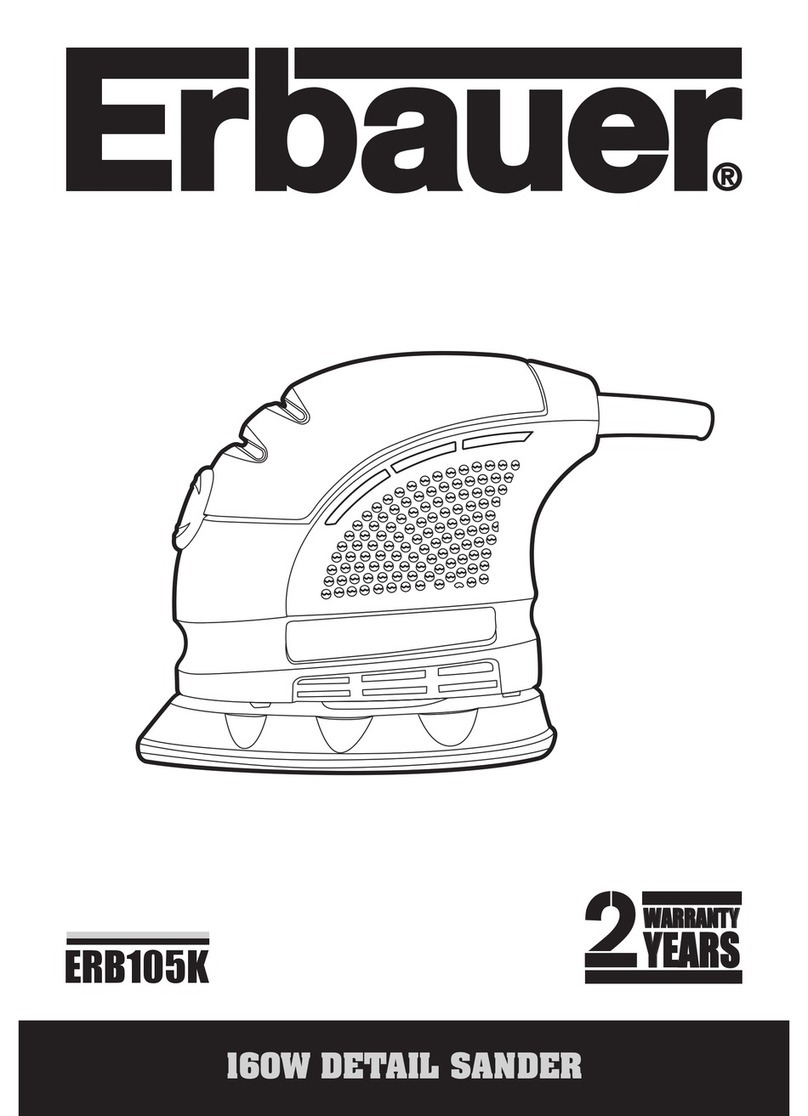
Erbauer
Erbauer ERB105K User manual
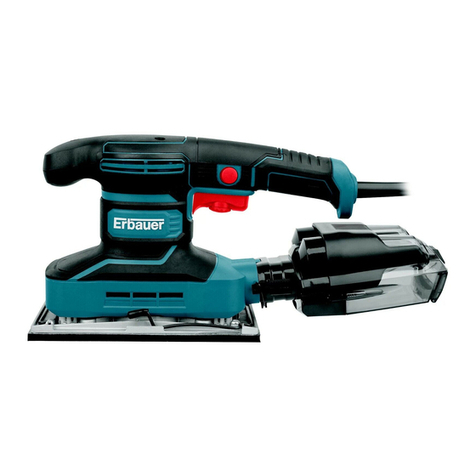
Erbauer
Erbauer ETSS260 User manual
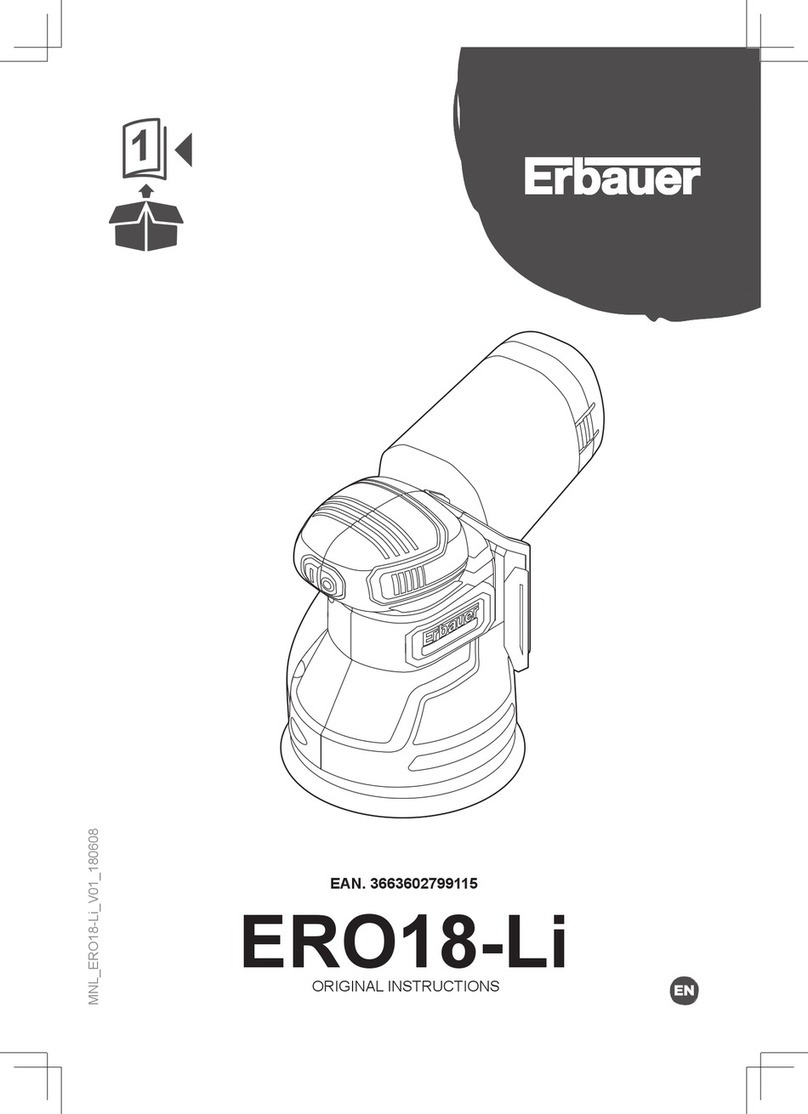
Erbauer
Erbauer ERO18-Li User manual

Erbauer
Erbauer ERB415SDR User manual

Erbauer
Erbauer ERB618SDR User manual
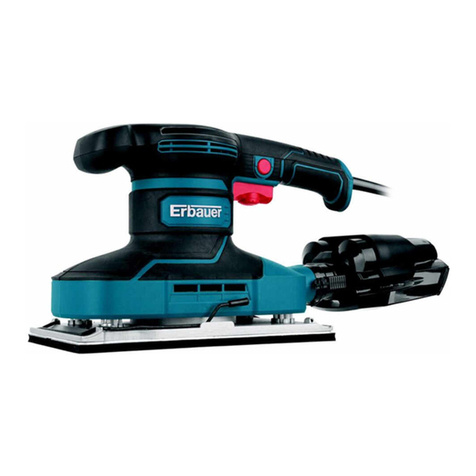
Erbauer
Erbauer EHSS350 User manual

Erbauer
Erbauer EDLS160 User manual
Popular Sander manuals by other brands
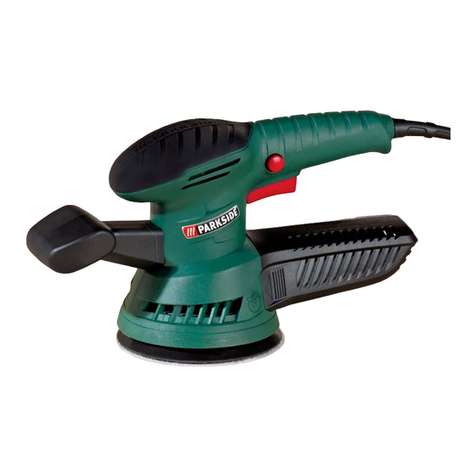
Parkside
Parkside XQ 270 - MANUEL 3 Operation and safety notes

Westfalia
Westfalia 802410 instruction manual

Festool
Festool Rotex RO 150 FEQ instruction manual
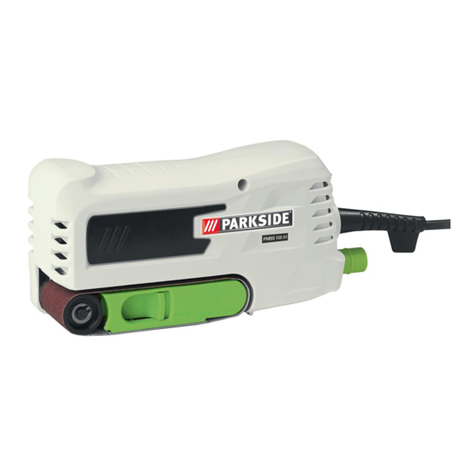
Parkside
Parkside PMBS 105 A1 Operation and safety notes
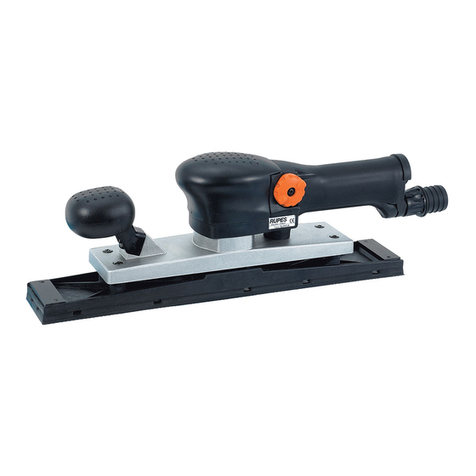
Rupes
Rupes SLP41A Operating and maintenance instructions
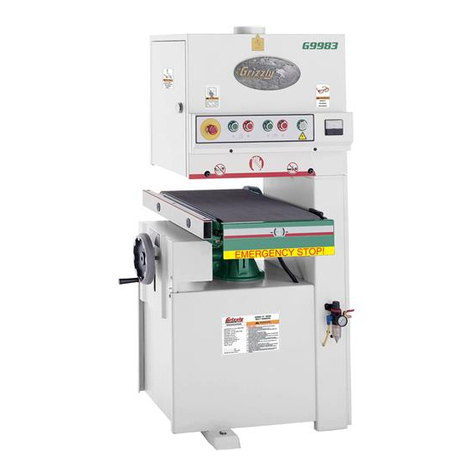
Grizzly
Grizzly G9983 owner's manual
